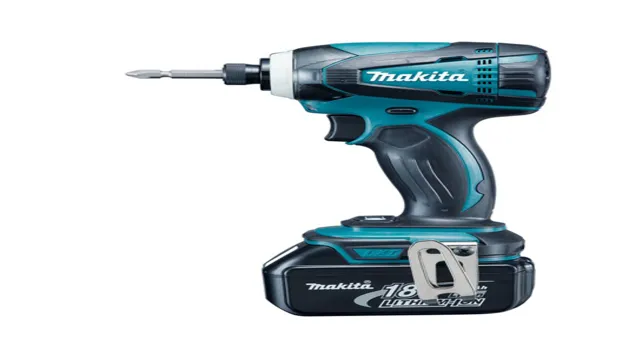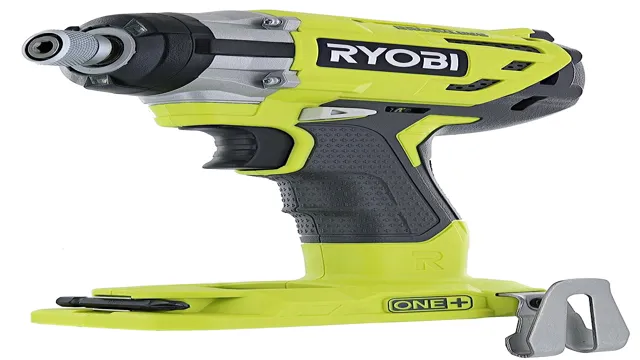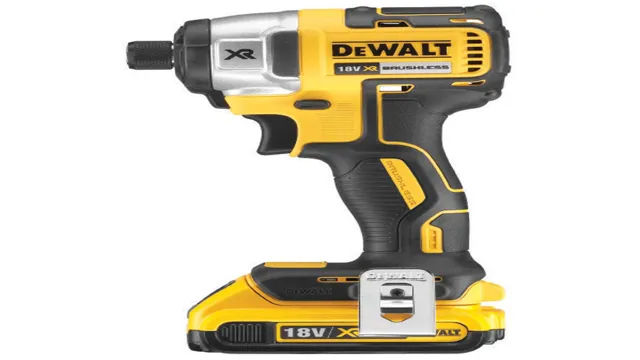What is the Difference Between Impact Driver and Cordless Drill: A Comprehensive Guide
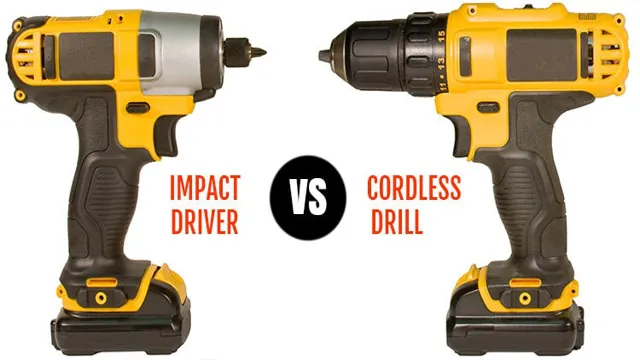
If you’re new to DIY projects or you’re simply looking for the right tool to help you complete a specific job, you might be wondering what the difference is between an impact driver and a cordless drill. While both tools may look similar and have the same basic function of drilling holes and driving screws, there are a few key differences that set them apart. Understanding these differences can help you choose the best tool for your specific needs and ensure that you get the results you want.
So, let’s dive in and explore the differences between these two essential tools.
Definition and Function
When it comes to power tools, two of the most common tools that people often get confused about are impact drivers and cordless drills. While both of them are battery-powered and can be used for drilling and driving tasks, they have key differences that make them unique. Cordless drills are versatile and can handle a wider range of tasks, including drilling holes in various materials, driving screws, and even sanding or polishing surfaces with the right attachments.
On the other hand, impact drivers are specifically designed for driving screws and bolts into tough materials, like wood and metal. They have an impact mechanism that creates high torque and allows them to work efficiently with minimal added pressure from the user. So, if you’re looking for a tool that can do both drilling and driving, a cordless drill is the way to go.
But if you need a tool that can handle tough driving tasks with ease, you’ll want to opt for an impact driver.
Impact Driver
An impact driver is a powerful tool that is commonly used to fasten screws, nuts, and bolts into various materials such as wood, metal, and concrete. It is a specialized type of drill that uses rotational force combined with high torque to produce a sudden, forceful burst of power that helps drive in tight screws more easily. Unlike a regular drill, the impact driver has a collet chuck that accommodates hexagonal screwdriver bits, making it easier to switch between different sizes of screws.
The main advantage of using an impact driver is that it can provide more torque and power than a regular drill, which can help you get the job done quickly and efficiently. Whether you are a professional builder or a DIY enthusiast, an impact driver can be an indispensable tool in your collection for tackling tough fastening jobs.
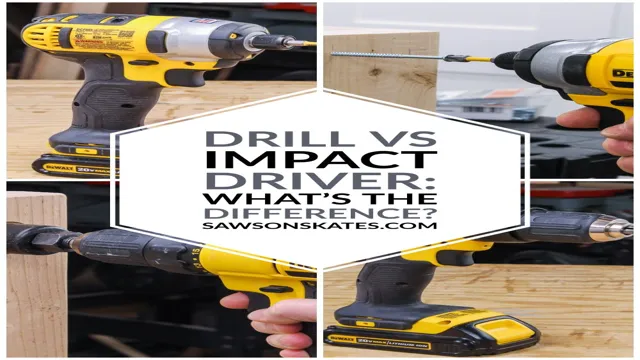
Cordless Drill
A cordless drill is a portable power tool that is designed to perform drilling and driving tasks in different materials without the need for a power outlet. It operates using a rechargeable battery that powers its motor, enabling it to deliver torque and rotational power to the drill bit or screw-driving bit. Cordless drills vary in size and power, with some models being suitable for light-duty DIY projects at home, while others are designed for heavy-duty commercial construction projects.
The flexibility of cordless drills makes them indispensable tools for both homeowners and professionals. From hanging pictures to building houses, cordless drills can easily handle a wide range of tasks with ease and convenience, making them a must-have item for any toolbox.
Torque and Power
When it comes to choosing between an impact driver and a cordless drill, understanding the difference between torque and power can help make your decision easier. Torque is the measurement of rotational power, while power is the measurement of work over time. An impact driver delivers high torque, making it ideal for driving screws into dense materials like hardwood.
Its unique mechanism also helps prevent cam-out, which can ruin screwheads. On the other hand, a cordless drill is designed for drilling holes and screwing into softer materials. It delivers high power and speed, making it ideal for fastening small screws and drilling pilot holes.
While both tools have their strengths, it’s important to choose the right one for your project to get the best results. So, if you’re working with hardwood or need to drive large screws, consider an impact driver. But, if you’re working with softwood or need to drill pilot holes, a cordless drill is the way to go.
Impact Driver
An impact driver is a powerful tool that can come in handy for completing a wide range of tasks that require intense torque. This device is especially useful for tasks that require driving screws, tightening nuts and bolts, or drilling through dense materials. The torque and power of an impact driver make it ideal for heavy-duty tasks where a traditional drill would struggle to deliver enough force.
With their high RPM (revolutions per minute) and powerful motor, impact drivers can produce more torque than a traditional drill, which translates into faster and more efficient performance. Additionally, impact drivers have features such as multiple speed settings and adjustable torque, allowing users to customize their work to their desired specifications. With an impact driver, completing challenging tasks is easier and less time-consuming, making it a crucial tool in any toolkit.
Cordless Drill
When it comes to cordless drills, two important factors to consider are torque and power. Torque is the twisting force applied to the drill bit and determines how well it can handle tough materials like concrete or thick wood. Power, on the other hand, refers to the speed of the drill and how quickly it can rotate the bit.
A drill with high torque and low power may be able to handle tough materials but take a longer time to do so, while a drill with high power and low torque may be fast but struggle with tougher materials. It’s important to find the right balance for your specific needs. In other words, it’s like finding the right car for your daily commute.
Some prefer a car with high horsepower to zoom through highways while others prefer one with high torque to navigate steep hills and off-road terrains. Understanding the difference between torque and power will help you make an informed decision when choosing a cordless drill.
Speed
If you’re into DIY projects or construction work, you may be wondering what the difference is between an impact driver and a cordless drill. The main difference lies in their speed and torque. An impact driver has higher torque compared to a cordless drill, which means it can handle tougher tasks such as driving large screws into solid materials.
On the other hand, a cordless drill is better suited for tasks that require lower torque and slower speeds, such as drilling holes. Additionally, impact drivers have an internal mechanism that creates a rotational force, allowing them to work faster and with less effort, while cordless drills work at a steady speed. Ultimately, both tools have their own uses, and it depends on the task at hand.
If you’re planning to do heavy-duty work, an impact driver would be the better choice, but for simpler tasks, a cordless drill will suffice.
Impact Driver
When it comes to impact drivers, speed is one of the most sought-after qualities. If you’re familiar with using a drill, you know that the speed can make all the difference in the world. An impact driver, however, takes things to a whole new level.
The rotational force it delivers is unparalleled, which is why it’s often the tool of choice for professionals. The high speed at which it operates allows for greater precision and accuracy. Plus, the quick bursts of power ensure that the screw or bolt is driven into the material effectively.
In other words, it makes for a more efficient and effective process overall. So if you’re looking for a tool that can handle tough jobs quickly and with great precision, an impact driver with high speed is definitely worth considering.
Cordless Drill
When it comes to cordless drills, speed is a crucial factor to consider. Most cordless drills come with variable speed settings, which give the user more control over the drilling process. The speed of the drill is measured in rotations per minute (RPM), and the higher the RPM, the faster the drill bit spins.
The speed of the drill can be adjusted according to the material being drilled into. For example, if you are drilling into a softer material like wood, a lower speed would be sufficient. On the other hand, if you are drilling into a harder material like metal, a higher speed would be required.
It is essential to choose a cordless drill with multiple speed settings to ensure that you can adjust the speed according to your needs. Moreover, always remember to use the right drill bit for the material being drilled and adjust the speed accordingly to get the best results. A cordless drill with variable speed settings gives you the flexibility you need to take on any job with ease.
Versatility
When it comes to choosing between an impact driver and a cordless drill, versatility is the key factor that sets them apart. While both tools have some similarities, the main difference lies in the way they deliver torque to the screw or bolt. Cordless drills are designed for drilling holes and fastening screws, with a clutch that can be adjusted for precise control over the torque.
On the other hand, impact drivers are built with a hammer and anvil mechanism that delivers a tremendous amount of torque for heavy-duty tasks, making them ideal for driving screws and loosening stuck bolts. So, if you need a tool that can handle a wide range of tasks, a cordless drill is the way to go. However, if you’re looking for a tool that can handle tough, high-torque jobs, you should invest in an impact driver.
Ultimately, the choice depends on your needs and the type of work you will be doing, but either way, both tools are essential for any DIY project or professional job.
Impact Driver
Impact Driver When it comes to power tools, versatility is always a desirable trait. And when it comes to versatility, an impact driver is hard to beat. This type of tool combines the powerful torque of an impact wrench with the precision of a drill.
This means it can handle a wide range of tasks, from driving screws into thick materials to drilling holes in metal. The impact action also makes it easier to work with stubborn screws or bolts, as it provides additional force to help break them loose. Additionally, impact drivers are often more compact and lightweight than traditional drills, making them easier to maneuver in tight spaces.
Overall, if you’re looking for a tool that can handle multiple tasks and make your DIY projects easier, an impact driver is a great investment.
Cordless Drill
When it comes to power tools, versatility is key. And that’s where cordless drills really shine. Whether you’re a professional tradesperson or a DIY enthusiast, a cordless drill can help with a wide variety of tasks.
From simple jobs like hanging shelves or putting together furniture to more complex tasks like drilling into hard materials or tightly spaced areas, a cordless drill is an essential tool in any toolbox. With the freedom of movement that comes from being cordless, you can take your projects anywhere without worrying about finding the nearest outlet. And with a rechargeable battery, you’ll always have power on hand to get the job done.
So, if you’re looking for a versatile power tool that can handle anything you throw at it, a cordless drill is definitely worth considering.
Conclusion
In conclusion, the difference between an impact driver and cordless drill can be summed up in one word: power. While a cordless drill is versatile and can handle a wide range of drilling tasks, an impact driver delivers an extra punch of torque that is ideal for driving screws and bolts into tough materials like hardwood and metal. Think of it like this: a cordless drill is the well-rounded athlete on the team, while the impact driver is the muscle-bound powerlifter.
Each has their own strengths and weaknesses, but with both in your toolbox, there’s no job you can’t handle like a pro.”
FAQs
What is an impact driver and how is it different from a cordless drill?
An impact driver is a power tool designed specifically for driving screws and bolts. It delivers high torque output with minimal effort due to its internal mechanism, while a cordless drill is a versatile tool that can be used for drilling, driving screws, and even mixing. While a cordless drill can also adapt to different bits such as a spade bit or hole saw, an impact driver’s hexagonal chuck is designed to only hold quarter-inch hex shank bits.
Which is better for driving screws, an impact driver or a cordless drill?
An impact driver is better suited for driving screws. Its high torque output allows it to drive screws with ease, especially when it comes to long or thick screws. A cordless drill, on the other hand, may struggle with driving long or thick screws due to its lower torque output.
Can a cordless drill be used as an impact driver?
While a cordless drill may have an impact setting, it cannot function as an impact driver. An impact driver’s mechanism is specific to delivering torque in a rotational and concussive manner, while a cordless drill’s main function is to apply a steady and consistent rotation to the bit.
What types of projects would benefit from using an impact driver?
Projects that require driving long or thick fasteners and projects that involve working with harder materials, such as hardwoods or metals, would benefit from using an impact driver.
Are there any downsides to using an impact driver over a cordless drill?
While an impact driver is great for driving screws, it may not be the best tool for drilling holes as it lacks the precision and control that a cordless drill provides. Additionally, the concussive force of an impact driver may cause the bit to slip or damage the material if used improperly.
How do I choose between an impact driver and a cordless drill?
Consider the type and frequency of projects you will be working on. If you will primarily be driving screws or working with harder materials, an impact driver may be the better choice. If you will need a tool for drilling holes and driving screws, a cordless drill may be the more versatile option.
Can an impact driver replace a manual screwdriver?
An impact driver can definitely replace a manual screwdriver. Its high torque output and quick speed make driving screws a breeze, especially for larger projects. Additionally, an impact driver can ensure consistent and tight screw placement, which can be difficult to achieve with a manual screwdriver.
